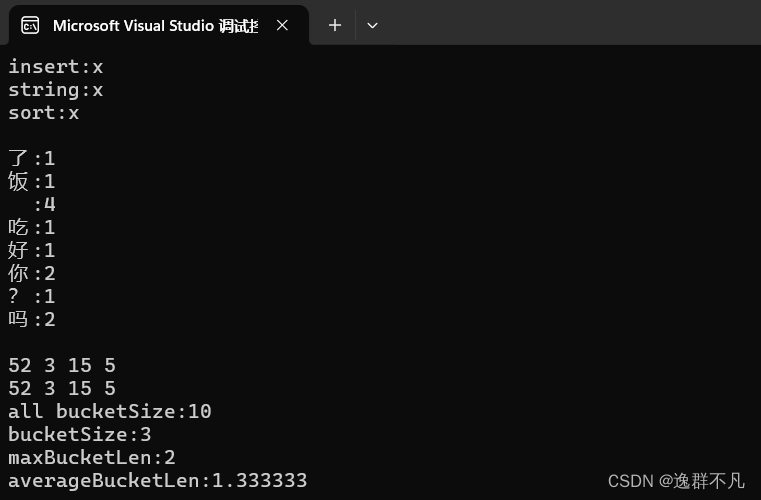本文主要是介绍C++|哈希结构封装unordered_set和unordered_map,希望对大家解决编程问题提供一定的参考价值,需要的开发者们随着小编来一起学习吧!
上一篇章,学习了unordered系列容器的使用,以及哈希结构,那么这一篇章将通过哈希结构来封装unordered系列容器,来进一步的学习他们的使用以及理解为何是如此使用。其实,哈希表的封装方式和红黑树的封装方式形式上是差不多的,如果有了红黑树的封装理解经验,我相信在理解哈希封装的过程会减少负担的。当然,在使用哈希结构中采用的是更具代表的哈希桶,接下来进行封装。
一、改造哈希表
1.1模板参数列表的改造
同理模板参数列表的改造跟红黑树的改造差不多。
K:关键码类型
V:不同容器v的容器类型不同,如果是unordered_map,v代表一个键值对,如果是unordered_set,v为k
KeyOfT:因为v的类型不同,通过keyOfT取key的方式就不同 。
Hash:哈希函数仿函数对象类型,哈希函数使用除留余数法,需要将字符串类型转化为整形数字才能取模。
1.2增加哈希表迭代器操作
1.2.1哈希表迭代器框架
//前置声明,迭代器中才能定义HashTable对象template<class K, class T, class KeyOfT, class hash>class HashTable;template<class K,class T,class Ref,class Ptr,class KeyOfT,class hash = HashFunc<K>>struct _HTIterator{typedef _HTIterator<K,T, Ref, Ptr,KeyOfT,hash> Self;//方便作为接收迭代器操作的返回值的类型typedef HashNode<T> Node;typedef Node* PNode;PNode _node;//定义节点指针,方便访问其成员来完成迭代器的操作HashTable<K, T, KeyOfT, hash>* _ht;//定义哈希表指针,方便使用其成员来完成迭代器的操作size_t _hashi;//记录迭代器访问的位置_HTIterator(PNode node, HashTable<K, T, KeyOfT, hash>* ht,size_t hashi):_node(node),_ht(ht),_hashi(hashi){}//....};1.2.2operator*() && operator->()
Ref operator*(){return _node->_data;}Ptr operator->(){return &(_node->_data);}1.2.3operator++()
Self& operator++(){if (_node->_next)//下一个元素不为空{_node = _node->_next;}else{/*hash hs;KeyOfT oft;int hashi = hs(oft(this->_data) % _tables.size());*///寻找下一个不为空的桶++_hashi;while(_hashi < _ht->_tables.size()){if (_ht->_tables[_hashi] != nullptr){_node = _ht->_tables[_hashi];break;}++_hashi;}//到末尾还没有找到不为空的桶if(_hashi == _ht->_tables.size())_node = nullptr;}return *this;}1.2.4operator--()
Self operator--(){PNode cur = _ht->_tables[_hashi];//当前节点就是第一个节点if (cur->_next == nullptr){//寻找上一个非空桶--_hashi;while (_hashi){//寻找该非空桶的最后一个元素if (_ht->_tables[_hashi]){cur = _ht->_tables[_hashi];while (cur->_next){cur = cur->_next;}_node = cur;break;}_hashi--;}}else{while (cur->_next != _node){cur = cur->_next;}_node = cur;}return *this;}1.2.5operator==() && operator!=()
bool operator==(const Self& x){return _node == x._node;//由于没有重复的元素,直接比较节点的地址}bool operator!=(const Self& x){return _node != x._node;}
二、如何用哈希表搭配unordered_map和unordered_set(仿函数)
我们可以用两张哈希表分别封装一份unordered_map和一份unordered_set,但是这样做的效果就带来了代码冗余。为了减少代码冗余,模拟跟库保持用一张哈希表封装unordered_map和unordered_set,但是该如何做到套用一张表呢,我们来进一步分析。
首先对于unordered_map而言,其存放的节点值是pair,而对于unordered_set存放的是key,这对于哈希表节点的实现到是没啥问题,但是对于哈希表内部的构造,是需要查询插入的位置,就需要进行比较,若将比较实现成key的比较,那么对于pair类型又该如何比较,虽然知道比较的也是pair中的key,但是如何做到既满足unordered_set中的key类型比较,又满足pair类型中的key比较,总不能干两份代码吧。这个时候,我们的仿函数又派上用场了,对于unordered_set和unordered_map中都构造一个仿函数,分别表示取到unordered_set的key,和unordered_map中pair中的key,那么哈希表中的比较,就可以换成仿函数的比较,当往unordered_set中插入元素进行比较,调用的就是unordered_set的仿函数,当往unordered_map中插入元素进行比较,调用的就是unordered_map的仿函数从而达到回调。用一张图来进行表示,如图:

三、哈希表封装unordered_map和unordered_set(简易版)
3.1哈希表的实现(HashTable.h)
//哈希桶/链地址法
namespace Hash_Bucket
{template<class T>struct HashNode{HashNode(const T& data):_next(nullptr),_data(data){}HashNode<T>* _next;T _data;};//前置声明,迭代器中才能定义HashTable对象template<class K, class T, class KeyOfT, class hash>class HashTable;template<class K,class T,class Ref,class Ptr,class KeyOfT,class hash = HashFunc<K>>struct _HTIterator{typedef _HTIterator<K,T, Ref, Ptr,KeyOfT,hash> Self;typedef HashNode<T> Node;typedef Node* PNode;PNode _node;HashTable<K, T, KeyOfT, hash>* _ht;size_t _hashi;_HTIterator(PNode node, HashTable<K, T, KeyOfT, hash>* ht,size_t hashi):_node(node),_ht(ht),_hashi(hashi){}Self& operator++(){if (_node->_next){_node = _node->_next;}else{/*hash hs;KeyOfT oft;int hashi = hs(oft(this->_data) % _tables.size());*/++_hashi;while(_hashi < _ht->_tables.size()){if (_ht->_tables[_hashi] != nullptr){_node = _ht->_tables[_hashi];break;}++_hashi;}if(_hashi == _ht->_tables.size())_node = nullptr;}return *this;}Self operator--(){PNode cur = _ht->_tables[_hashi];//当前节点就是第一个节点if (cur->_next == nullptr){//寻找上一个非空桶--_hashi;while (_hashi){//寻找该非空桶的最后一个元素if (_ht->_tables[_hashi]){cur = _ht->_tables[_hashi];while (cur->_next){cur = cur->_next;}_node = cur;break;}_hashi--;}}else{while (cur->_next != _node){cur = cur->_next;}_node = cur;}return *this;}Ref operator*(){return _node->_data;}Ptr operator->(){return &(_node->_data);}bool operator==(const Self& x){return _node == x._node;//由于没有重复的元素,直接比较节点的地址}bool operator!=(const Self& x){return _node != x._node;}};template<class K,class T,class KeyOfT,class hash>class HashTable{//声明友元,迭代器方可访问该类中的私有成员template<class K, class T, class Ref, class Ptr, class KeyOfT,class hash>friend struct _HTIterator;public:typedef _HTIterator<K, T,T&, T*, KeyOfT,hash> iterator;typedef _HTIterator<K, T, const T&, const T*, KeyOfT, hash> const_iterator;typedef HashNode<T> Node;typedef Node* PNode;HashTable(size_t size = 10){_tables.resize(size);}iterator begin(){for (int i = 0; i < _tables.size(); i++){if (_tables[i] != nullptr)return iterator(_tables[i], this, i);}return end();}iterator end(){return iterator(nullptr,this,-1);}const_iterator begin() const{for (int i = 0; i < _tables.size(); i++){if (_tables[i] != nullptr)return iterator(_tables[i], this, i);}return end();}const_iterator end() const{return iterator(nullptr, this, -1);}iterator Find(const K& key){KeyOfT oft;hash hs;int hashi = hs(key) % _tables.size();PNode cur = _tables[hashi];while (cur){if(hs(oft(cur->_data)) == hs(key))return iterator(cur, this, hashi);cur = cur->_next;}return iterator(nullptr, this, -1);}pair<iterator,bool> Insert(T data){hash hs;KeyOfT oft;iterator it = Find(oft(data));if (it != end())return make_pair(it,false);//扩容if (_n == _tables.size()){vector<PNode> _newHT(_tables.size()*2);for (int i = 0; i < _tables.size(); i++){PNode cur = _tables[i];while (cur){PNode next = cur->_next;int hashi = hs(oft(_tables[i]->_data)) % _newHT.size();//元素一直在变,所以不能用_tables[i]做代表/*_tables[i]->_next = nullptr;_newHT[hashi] = _tables[i];*/cur->_next = nullptr;_newHT[hashi] = cur;cur = next;}_tables[i] = nullptr;}_tables.swap(_newHT);}//头插PNode newnode =new Node(data);int hashi = hs(oft(data)) % _tables.size();newnode->_next = _tables[hashi];_tables[hashi] = newnode;++_n;return make_pair(iterator(newnode, this, hashi),true);}bool Erase(const K& key){KeyOfT oft;iterator it = Find(key);if (it == end())return false;hash hs;int hashi = hs(key) % _tables.size();PNode cur = _tables[hashi];PNode parent = nullptr;while (hs(oft(cur->_data)) != hs(key)){parent = cur;cur = cur->_next;}if (parent){delete cur;parent->_next = nullptr;}else{delete cur;_tables[hashi] = nullptr;}return true;}~HashTable(){for (int i = 0; i < _tables.size(); i++){PNode cur = _tables[i];while (cur){PNode next = cur->_next;delete cur;cur = next;}_tables[i] = nullptr;}}//另外加的,为了测试用void Some(){size_t bucketSize = 0;size_t maxBucketLen = 0;size_t sum = 0;double averageBucketLen = 0;for (size_t i = 0; i < _tables.size(); i++){Node* cur = _tables[i];if (cur){++bucketSize;}size_t bucketLen = 0;while (cur){++bucketLen;cur = cur->_next;}sum += bucketLen;if (bucketLen > maxBucketLen){maxBucketLen = bucketLen;}}averageBucketLen = (double)sum / (double)bucketSize;printf("all bucketSize:%d\n", _tables.size());printf("bucketSize:%d\n", bucketSize);printf("maxBucketLen:%d\n", maxBucketLen);printf("averageBucketLen:%lf\n\n", averageBucketLen);}private:vector<HashNode<T>*> _tables;size_t _n = 0;};}3.2unordered_map的模拟实现(My_Unordered_Map.h)
#pragma once#include "HashTable.h"namespace Hash_Bucket
{template<class K,class V,class Hash = HashFunc<K>>class unordered_map{public:struct KeyOfTMap{const K& operator()(const pair<const K, V>& data){return data.first;}};typedef typename HashTable<K, pair<const K,V>, KeyOfTMap, Hash>::iterator iterator;typedef typename HashTable<K, pair<const K,V>, KeyOfTMap, Hash>::const_iterator const_iterator;iterator begin(){return _hs.begin();}iterator end(){return _hs.end();}const_iterator begin() const{return _hs.begin();}const_iterator end() const{return _hs.end();}pair<iterator, bool> insert(const pair<K,V>& data){return _hs.Insert(data);}V& operator[](const K& key){pair<iterator, bool> ret = _hs.Insert(make_pair(key,V()));return ret.first->second;}bool erase(const K& key){return _hs.Erase(key);}iterator find(const K& key){return _hs.Find(key);}private:HashTable<K, pair<const K,V>, KeyOfTMap, Hash> _hs;};void test_map(){unordered_map<string, string> dict;dict.insert(make_pair("sort", ""));dict.insert(make_pair("string", ""));dict.insert(make_pair("insert", ""));for (auto& kv : dict){//kv.first += 'x';kv.second += 'x';cout << kv.first << ":" << kv.second << endl;}cout << endl;string arr[] = { "你", " ","好", " ", "吗", " ", "你", "吃", " ", "了", "饭", "吗", "?" };unordered_map<string, int> count_map;for (auto& e : arr){count_map[e]++;}for (auto& kv : count_map){cout << kv.first << ":" << kv.second << endl;}cout << endl;}
}
3.3unordered_set的模拟实现(My_Unordered_Set.h)
#pragma once#include "HashTable.h"namespace Hash_Bucket
{template<class K,class Hash = HashFunc<K>>class unordered_set{public:struct KeyOfTSet{const K& operator()(const K& key){return key;}};typedef typename HashTable<K, const K, KeyOfTSet, Hash>::iterator iterator;typedef typename HashTable<K, const K, KeyOfTSet, Hash>::const_iterator const_iterator;iterator begin(){return _hs.begin();}iterator end(){return _hs.end();}const_iterator begin() const{return _hs.begin();}const_iterator end() const{return _hs.end();}pair<iterator, bool> insert(const K& key){return _hs.Insert(key);}bool erase(const K& key){return _hs.Erase(key);}iterator find(const K& key){return _hs.Find(key);}void some(){_hs.Some();}private:HashTable<K, const K, KeyOfTSet, Hash> _hs;};void test_set(){unordered_set<int> us;us.insert(5);us.insert(15);us.insert(52);us.insert(3);unordered_set<int>::iterator it = us.begin();while (it != us.end()){//*it += 5;cout << *it << " ";++it;}cout << endl;for (auto e : us){cout << e << " ";}cout << endl;us.some();}}
3.4测试(test.cpp)
#include "My_Unordered_Map.h"
#include "My_Unordered_Set.h"int main()
{Hash_Bucket::test_map();Hash_Bucket::test_set();return 0;
}输出结果:

这篇关于C++|哈希结构封装unordered_set和unordered_map的文章就介绍到这儿,希望我们推荐的文章对编程师们有所帮助!






